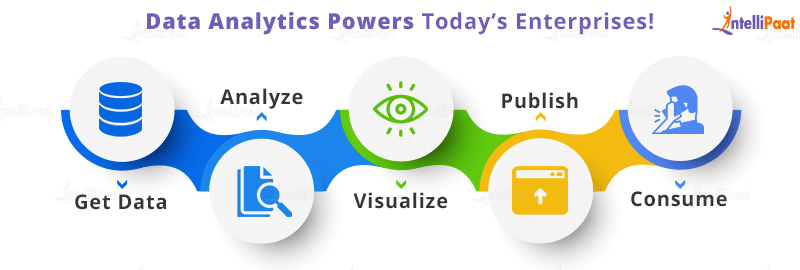Introduction to Data Analytics
Today, practically every firm has evolved into a data-driven organization, which implies that they are implementing a strategy to acquire more data about their customers, markets, and business processes. This data is then classified, saved, and analyzed in order to make sense of it and gain useful insights.
Table of contents:
- What is Data Analytics?
- Why is Data Analytics important?
- Data Analytics tools
- How to become a Data Analyst
- Career Scope in Data Analytics
What is Data Analytics?
Most businesses are constantly collecting data, but this data is meaningless in its raw form. This is when data analytics enters the game. Data analytics is the process of analyzing raw data to derive meaningful, actionable insights that can subsequently be utilized to inform and drive smart business decisions.

A data analyst will take raw data, arrange it, and then analyze it, changing it from unintelligible statistics into cohesive, understandable information. After interpreting the data, the data analyst will share their findings in the form of suggestions or recommendations for the company’s next steps.
Data analytics allows you to make sense of the past and predict future patterns and behaviors; rather than relying on guessing, you can make informed decisions based on what the data is showing you.
Armed with data insights, businesses and organizations can gain a much deeper understanding of their audience, industry, and firm as a whole—and, as a result, are much more positioned to make decisions and plan forward.
Check out our blog on Data Science tutorial to learn more about Data Science.
Why is Data Analytics important?
Data analytics plays an important part in business improvement since it is utilized to collect hidden insights, develop reports, conduct market studies, and improve business requirements.
Data analysis is a type of internal arrangement in which numbers and figures are presented to management. With the help of data analytics, enterprises will be able to decide on customer trends and behavior forecasting, boost business revenues, and promote efficient decision-making.
Role of Data Analytics:
- Gather Hidden Insights- Data is mined for hidden insights, which are then analyzed in light of business requirements.
- Generate Reports- Reports are generated from the data and distributed to the appropriate teams and individuals to deal with additional steps for a successful business.
- Perform Market Analysis- Market analysis can be used to determine the strengths and weaknesses of competitors.
- Improve Business Requirements- Data analysis enables businesses to better meet the needs and expectations of their customers.
Data Analytics tools
With the growing market demand for Data Analytics, different tools with varying functionality have arisen. The top data analytics tools, whether open-source or user-friendly, are as follows.
- Python: This is the most widely used analytics tool for statistics and data modeling. R can be compiled and run on a variety of systems, including UNIX, Windows, and Mac OS.
- R programming: Python is an object-oriented programming language that is open source and simple to learn, develop, and maintain. It includes libraries for machine learning and visualization such as Scikit-learn, TensorFlow, Matplotlib, Pandas, and Keras.
- Tableau Public: This is a free program that links to any data source, including Excel and corporate data warehouses. It then generates visualizations, maps, dashboards, and other web-based tools with real-time changes.
- SAS: This tool, which is a programming language and environment for data manipulation and analytics, is simple to use and can analyze data from various sources.
- Microsoft Excel: This is a popular data analytics tool. This tool examines tasks that summarize data with a preview of pivot tables and is mostly used for clients’ internal data.
- Apache Spark: This tool executes applications on Hadoop clusters 100 times quicker in memory and 10 times faster in storage, making it one of the largest large-scale data processing engines. This tool is also widely used for developing data pipelines and machine learning models.
- RapidMiner: A sophisticated, integrated platform capable of integrating with any sort of data source, including Access, Excel, Microsoft SQL, Teradata, Oracle, and Sybase. This technology is usually used for predictive analytics, such as data mining, text analytics, and machine learning.
Prepare yourself for the industry by going through these Data Analyst Interview Questions now!
How to become a Data Analyst
Academic Qualifications
It is recommended to have a strong CGPA and a graduation degree from a data analysis program. Even if a person does not specialize in data analysis, a degree in mathematics, statistics, or economics from a well-known university can lead to an entry-level Data Analyst position.
A bachelor’s degree is required for entry-level data analyst positions. Higher-level data analyst jobs normally pay more and may require a master’s degree. Aside from the degree, a person interested in becoming a Data Analyst may enroll in online courses.
Skills
- Technical Skills
Programming Languages: A Data Analyst should be familiar with at least one programming language. R, Python, C++, Java, MATLAB, PHP, and other programming languages are among those that can be used to edit data.
Data Management and Manipulation: A Data Analyst should be familiar with programming languages such as R, HIVE, SQL, and others. Developing queries to retrieve the relevant data is a critical component of Data Analytics.
- Soft Skills
A data analyst is in charge of giving management accurate and trustworthy information. Data analysts must therefore have a thorough understanding of the data as well as each user’s specific requirements. Good communication skills are also required when working with others to ensure that the data is effectively aligned with the objectives.
- Practical Skills
Mathematical Ability: A Data Analyst must understand statistics and be conversant with the formulae required for data analysis in order to deliver real-world value. As a Data Analyst, you must understand mathematics and be able to handle common business problems. You must also understand how to use tables, charts, graphs, and other tools.
Microsoft Excel: Data Analysts’ primary responsibilities include organizing data and gathering numbers. As a result, it is important for a Data Analyst to be familiar with Excel.
Career Transition
Career Scope in Data Analytics
A Data Analyst can expect to make a significant amount of money, do fascinating work, and have a lot of job stability. This is a career that is always changing and diverse and requires a lot of attention to detail and a focus on quality. A profession in Data Analytics also provides excellent prospects for progression.
Data Analyst is a position that is clearly on the rise. The difference between mid-level and senior-level positions is determined by experience and extra education. However, because Data Analysts are in such great demand at all levels, job growth is expected to be positive for each tier over the next decade, ranging from 5% for a Financial Analyst to 25% for an Operations Research Analyst.
The post Introduction to Data Analytics appeared first on Intellipaat Blog.
Blog: Intellipaat - Blog
Leave a Comment
You must be logged in to post a comment.





























